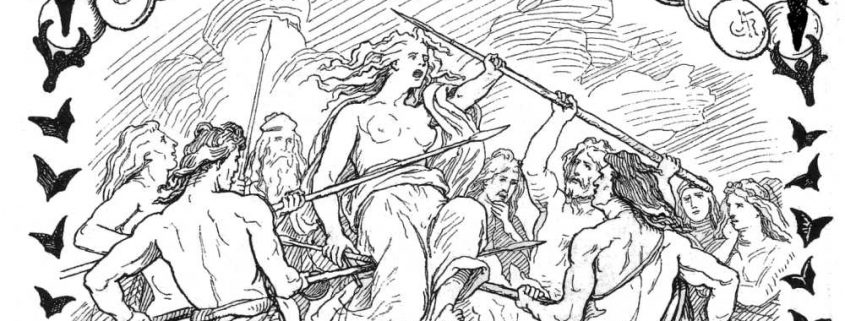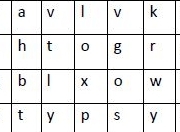The Burning of Gullveig
By Reginhard OR
“She that remembers, the first on earth,
when Gullveig they with lances pierced,
and in the high one’s hall her burnt,
thrice burnt, thrice brought forth, oft not seldom; yet she still lives.
Heidi they called her, whitherso’er she came,
the well-foreseeing Vala:
wolves she tamed, magic arts she knew, magic arts practiced;
ever she was the joy of evil people”
– Voluspa
In Sturlson’s Poetic Edda, Gullveig is characterised as a wicked money grabbing sorceress who when visiting Asgard talks of nothing other than the love of gold.
“They listened with loathing and eventually thought the world would be better off without her so they hurled her into the fire”
Gullveig is said to be one of the Vanir who visited the Aesir. For me this is where the tale gets a little strange. The Vanir are nature gods, so they would not have even cared about shining gold. The occupants of Svartalvheim are said to be the lovers of all that glitters, not the Vanir. So would a nature spirit be so easily distracted by baubles?
Of course the really strange bit is the Aesir’s response to her cooing over everything. “Shall we ask her to leave?”, “No let’s kill her!” and not just that, “let’s burn her alive!”
This seems like there is more to this than the barbecuing of a passing bling-fancier. Now let’s try and look again with clearer eyes at this tale and see if there is more to it.
In the way our tales were handed down, Gullveig is ritually burned three times, yet survives to continue as the Vala Heiðr or Heidi. It is presented as the creation of the love of gold amongst the Aesir, and the start of the war between them and the Vanir.
In some translations, the Norns arise from this burning and this act of the slaying of Gullveig is the first step towards the doom of the gods by the creation of the concept of time and it’s passing and in doing so, starts the clock towards the Ragnarok.
The etymology of the name Gullveig can be a little vague. Gull means gold, but Veig can translate as “alcoholic drink”, “power, strength”, and sometimes also “gold”. The name Heiðr or Heidi can mean “fame”, “bright” or “clear”.
For me it can be presented that as a Goddess, Gullveig is an embodiment of the earth so let’s work with the linguistics and see what can be found.
Firstly let’s take “Gold and “Alcoholic Drink”. In the fermentation of beer, toasting the barley is the key to a good, well-bodied ale. In the preparation of mead, it is useful to try not to endanger oneself to the honey’s rightful owners, so maybe spearing a beehive and smoking over a fire was a way of disposing of the bees.
Secondly lets have “Gold” and “Gold”. Now if the goddess is an archetype of the earth, it isn’t too far-fetched to suggest this could be the invention of mining. The Voluspa even states that this led to the love of gold. In smithing there are various stages of heating and reheating to achieve the best results.
Now let’s look at “Gold” and “Power/Strength”. It is too easy to tie this with the old chestnut of “money makes the world go round” and in a way it can and has been interpreted this way. I would like to propose another suggestion, what if the “power” was not a physical or tangible power. I would like to propose a metaphysical translation.
Gold is a conductor of energy and helps maintain an easy flow throughout the nervous system. It increases brain efficiency and the ability to repair damaged tissue. it is used for healing of the emotional, mental and spiritual aspects of the psyche. The mineral gold teaches a need to relax and let go. The obsession with this energy does lead to the uncontrolled desire to hoard piles of the stuff like Tolkien’s Dragon in The Hobbit.
So in the same way Odin hung upon the windswept tree and pierced with a spear, or that Freya achieved wisdom from the seven dwarves (yes those ones) Gullveig is pierced with spears and ritually burned three times. She survives the ritual as Heiðr or Heidi and leaves with skills of far sight, magic arts and the control of animals. So she has reached a level of understanding and advancement from undergoing the transformation and goes on to be “ the joy of evil people”, evil people is clearly practicing members of the indigenous faith we all know in its modern form as Odinism.
There is a scholarly footnote which is rather persistent that Gullveig is simply an aspect or embodiment of Freya. This is pure laziness and shows a lack of desire for investigating further whilst neatly underlining the whole topic. Whilst this feeling is prevalent in Pagan and Academic circles, there is no evidence supporting this other than citing works of other writers in the modern era.
In conclusion, Gullveig/Heidi has suffered the fate of all of our Goddesses and has been demonised into a witchy fight starter who was murdered by the wicked Aesir who then get what’s coming to them. We may be missing a whole slice of our philosophy without even realising.
We know this is typical of the ways our tales have been recorded and I would like to share this little article and hope it encourages others to read between the lines.
Through deeper understanding, we walk towards the New Awakening.
Hail our Holy Gods and Goddesses.








